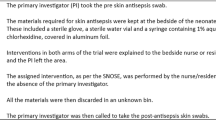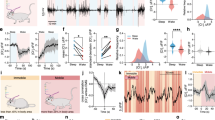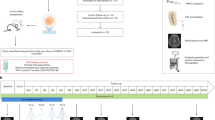Abstract
Background:
Chlorhexidine is a skin disinfectant that reduces skin and mucous membrane bacterial colonization and inhibits organism growth. Despite numerous studies assessing chlorhexidine safety in term infants, residual concerns have limited its use in hospitalized neonates, especially low-birth-weight preterm infants. The aim of this study was to assess the potential neurotoxicity of chlorhexidine on the developing central nervous system using a well-established in vitro model of neurite outgrowth that includes laminin and L1 cell adhesion molecule (L1) as neurite outgrowth–promoting substrates.
Methods:
Cerebellar granule neurons are plated on poly l-lysine, L1, or laminin. Chlorhexidine, hexachlorophene, or their excipients are added to the media. Neurons are grown for 24 h, fixed, and neurite length is measured.
Results:
Chlorhexidine significantly reduced the length of neurites grown on L1 but not on laminin. Chlorhexidine concentrations as low as 125 ng/ml statistically significantly reduced neurite length on L1. Hexachlorophene did not affect neurite length.
Conclusion:
Chlorhexidine at concentrations detected in the blood following topical applications in preterm infants specifically inhibited L1-mediated neurite outgrowth of cerebellar granule neurons. It is now vital to determine whether the blood–brain barrier is permeable to chlorhexidine in preterm infants.
Similar content being viewed by others
Log in or create a free account to read this content
Gain free access to this article, as well as selected content from this journal and more on nature.com
or
References
Climo MW, Sepkowitz KA, Zuccotti G, et al. The effect of daily bathing with chlorhexidine on the acquisition of methicillin-resistant Staphylococcus aureus, vancomycin-resistant Enterococcus, and healthcare-associated bloodstream infections: results of a quasi-experimental multicenter trial. Crit Care Med 2009;37:1858–65.
O’Horo JC, Silva GL, Munoz-Price LS, Safdar N . The efficacy of daily bathing with chlorhexidine for reducing healthcare-associated bloodstream infections: a meta-analysis. Infect Control Hosp Epidemiol 2012;33:257–67.
Milstone AM, Passaretti CL, Perl TM . Chlorhexidine: expanding the armamentarium for infection control and prevention. Clin Infect Dis 2008;46:274–81.
O’Grady NP, Alexander M, Burns LA, et al.; Healthcare Infection Control Practices Advisory Committee (HICPAC). Guidelines for the prevention of intravascular catheter-related infections. Clin Infect Dis 2011;52:e162–93.
Case DE . Chlorhexidine: attempts to detect percutaneous absorption in man. Proc Int Cong Chemother 1976;3:367–74.
Wilson CM, Gray G, Read JS, et al. Tolerance and safety of different concentrations of chlorhexidine for peripartum vaginal and infant washes: HIVNET 025. J Acquir Immune Defic Syndr 2004;35:138–43.
Mullany LC, Darmstadt GL, Tielsch JM . Safety and impact of chlorhexidine antisepsis interventions for improving neonatal health in developing countries. Pediatr Infect Dis J 2006;25:665–75.
Curley A, Kimbrough RD, Hawk RE, Nathenson G, Finberg L . Dermal absorption of hexachlorophene in infants. Lancet 1971;2:296–7.
Kopelman AE . Cutaneous absorption of hexachlorophene in low-birth-weight infants. J Pediatr 1973;82:972–5.
Tamma PD, Aucott SW, Milstone AM . Chlorhexidine use in the neonatal intensive care unit: results from a national survey. Infect Control Hosp Epidemiol 2010;31:846–9.
Bearer CF, Swick AR, O’Riordan MA, Cheng G . Ethanol inhibits L1-mediated neurite outgrowth in postnatal rat cerebellar granule cells. J Biol Chem 1999;274:13264–70.
Watanabe H, Yamazaki M, Miyazaki H, et al. Phospholipase D2 functions as a downstream signaling molecule of MAP kinase pathway in L1-stimulated neurite outgrowth of cerebellar granule neurons. J Neurochem 2004;89:142–51.
Komljenovic I, Marquardt D, Harroun TA, Sternin E . Location of chlorhexidine in DMPC model membranes: a neutron diffraction study. Chem Phys Lipids 2010;163:480–7.
Schmuck G, Schlüter G . An in vitro model for toxicological investigations of environmental neurotoxins in primary neuronal cell cultures. Toxicol Ind Health 1996;12:683–96.
Cowen J, Ellis SH, McAinsh J . Absorption of chlorhexidine from the intact skin of newborn infants. Arch Dis Child 1979;54:379–83.
Shuman RM, Leech RW, Alvord EC Jr . Neurotoxicity of hexachlorophene in the human: I. A clinicopathologic study of 248 children. Pediatrics 1974;54:689–95.
Tyrala EE, Hillman LS, Hillman RE, Dodson WE . Clinical pharmacology of hexachlorophene in newborn infants. J Pediatr 1977;91:481–6.
Chapman A, Aucott S, Gilmore M, et al. Absorption and tolerability of aqueous chlorhexidine gluconate used for skin antisepsis prior to catheter insertion in preterm neonates. J Perinatol 2013;33:768–71.
Nakai Y, Kamiguchi H . Migration of nerve growth cones requires detergent-resistant membranes in a spatially defined and substrate-dependent manner. J Cell Biol 2002;159:1097–108.
Tang N, Farah B, He M, et al. Ethanol causes the redistribution of L1 cell adhesion molecule in lipid rafts. J Neurochem 2011;119:859–67.
Dolganiuc A, Bakis G, Kodys K, Mandrekar P, Szabo G . Acute ethanol treatment modulates Toll-like receptor-4 association with lipid rafts. Alcohol Clin Exp Res 2006;30:76–85.
Littner Y, Tang N, He M, Bearer CF . L1 cell adhesion molecule signaling is inhibited by ethanol in vivo. Alcohol Clin Exp Res 2013;37:383–9.
Ghare S, Patil M, Hote P, et al. Ethanol inhibits lipid raft-mediated TCR signaling and IL-2 expression: potential mechanism of alcohol-induced immune suppression. Alcohol Clin Exp Res 2011;35:1435–44.
Blanco AM, Perez-Arago A, Fernandez-Lizarbe S, Guerri C . Ethanol mimics ligand-mediated activation and endocytosis of IL-1RI/TLR4 receptors via lipid rafts caveolae in astroglial cells. J Neurochem 2008;106:625–39.
Szabo G, Dolganiuc A, Dai Q, Pruett SB . TLR4, ethanol, and lipid rafts: a new mechanism of ethanol action with implications for other receptor-mediated effects. J Immunol 2007;178:1243–9.
Babich H, Wurzburger BJ, Rubin YL, Sinensky MC, Blau L . An in vitro study on the cytotoxicity of chlorhexidine digluconate to human gingival cells. Cell Biol Toxicol 1995;11:79–88.
Lessa FC, Aranha AM, Nogueira I, Giro EM, Hebling J, Costa CA . Toxicity of chlorhexidine on odontoblast-like cells. J Appl Oral Sci 2010;18:50–8.
Chang YC, Huang FM, Tai KW, Chou MY . The effect of sodium hypochlorite and chlorhexidine on cultured human periodontal ligament cells. Oral Surg Oral Med Oral Pathol Oral Radiol Endod 2001;92:446–50.
de Souza LB, de Aquino SG, de Souza PP, Hebling J, Costa CA . Cytotoxic effects of different concentrations of chlorhexidine. Am J Dent 2007;20:400–4.
Goldschmidt P, Cogen R, Taubman S . Cytopathologic effects of chlorhexidine on human cells. J Periodontol 1977;48:212–5.
Doan L, Piskoun B, Rosenberg AD, Blanck TJ, Phillips MS, Xu F . In vitro antiseptic effects on viability of neuronal and Schwann cells. Reg Anesth Pain Med 2012;37:131–8.
Tripier MF, Bérard M, Toga M, Martin-Bouyer G, Le Breton R, Garat J . Hexachlorophene and the central nervous system. Toxic effects in mice and baboons. Acta Neuropathol 1981;53:65–74.
Gongwer LE, Hubben K, Lenkiewicz RS, Hart ER, Cockrell BY . The effects of daily bathing of neonatal rhesus monkeys with an antimicrobial skin cleanser containing chlorhexidine gluconate. Toxicol Appl Pharmacol 1980;52:255–61.
Kronstein R, Seebach J, Grossklaus S, et al. Caveolin-1 opens endothelial cell junctions by targeting catenins. Cardiovasc Res 2012;93:130–40.
Wennberg RP . The blood-brain barrier and bilirubin encephalopathy. Cell Mol Neurobiol 2000;20:97–109.
Liebner S, Czupalla CJ, Wolburg H . Current concepts of blood-brain barrier development. Int J Dev Biol 2011;55:467–76.
Fransen E, D’Hooge R, Van Camp G, et al. L1 knockout mice show dilated ventricles, vermis hypoplasia and impaired exploration patterns. Hum Mol Genet 1998;7:999–1009.
Arifeen SE, Mullany LC, Shah R, et al. The effect of cord cleansing with chlorhexidine on neonatal mortality in rural Bangladesh: a community-based, cluster-randomised trial. Lancet 2012;379:1022–8.
Author information
Authors and Affiliations
Corresponding author
Rights and permissions
About this article
Cite this article
Milstone, A., Bamford, P., Aucott, S. et al. Chlorhexidine inhibits L1 cell adhesion molecule–mediated neurite outgrowth in vitro. Pediatr Res 75, 8–13 (2014). https://doi.org/10.1038/pr.2013.175
Received:
Accepted:
Published:
Issue date:
DOI: https://doi.org/10.1038/pr.2013.175
This article is cited by
-
Choline supplementation mitigates effects of bilirubin in cerebellar granule neurons in vitro
Pediatric Research (2024)
-
Myelin toxicity of chlorhexidine in zebrafish larvae
Pediatric Research (2023)
-
Hypothermia increases cold-inducible protein expression and improves cerebellar-dependent learning after hypoxia ischemia in the neonatal rat
Pediatric Research (2023)
-
Neonatal hypoxia ischemia redistributes L1 cell adhesion molecule into rat cerebellar lipid rafts
Pediatric Research (2022)
-
Bilirubin inhibits lipid raft dependent functions of L1 cell adhesion molecule in rat pup cerebellar granule neurons
Pediatric Research (2021)



